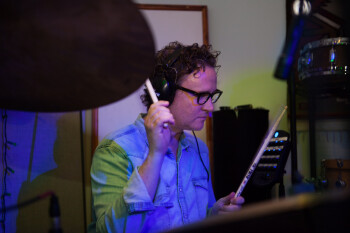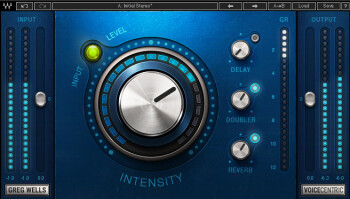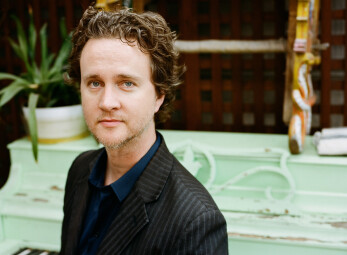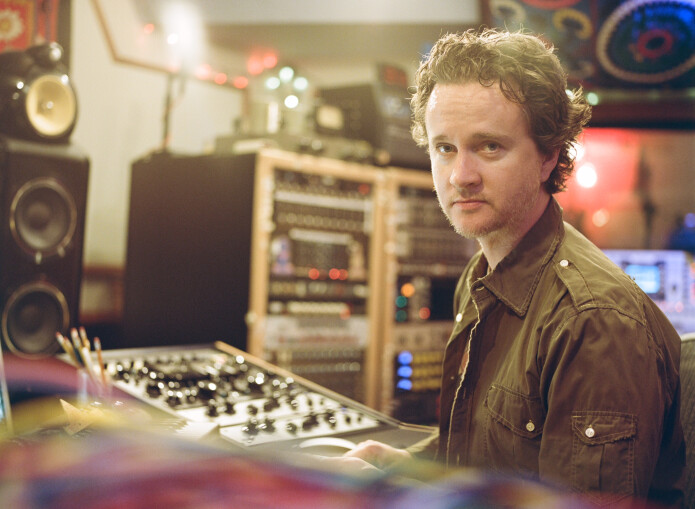Although he spent most of his childhood playing and studying music, it wasn’t until Greg Wells was 18 that he got bitten by the recording bug. “I got my parents to co-sign a loan, and I bought a Mac Plus and a Fostex 4-track cassette machine,” he recalls. “I bought an Alesis Microverb, a terrible microphone and a cheap compressor, and I became really enamored with the thought of trying to record music.”
From those humble beginnings, Wells has built a happening career as a producer, mix engineer, multi-instrumentalist and songwriter. He’s received multiple Grammy nominations, and his diverse credit list includes Katy Perry, Adele, Keith Urban, Twenty One Pilots, Timbaland, All American Rejects, Deftones, and Rufus Wainright, among many others.
He recently collaborated with Waves on the Greg Wells Signature Series plug-ins, which are designed to be both powerful and easy to use, and incorporate the type of processing he uses daily in the studio.
Audiofanzine had the opportunity to speak with Wells about his producing style, plug-ins, mixing techniques, and more.
On your website you say how you don’t want to impose a sound on artists you produce, but instead try to get the best out of their abilities.
I’m truly interested in people’s stories. One of my favorite questions to ask is, basically, what is your life story? How did you wind up from wherever you came from to what you’re doing now? The answers all are different. In the same way that everyone’s fingerprint is different, everyone’s music sounds different. You can’t really ever sound like somebody else. My favorite kind of people to work with are people that really, really don’t sound like somebody else. So the last thing I want to do is something that homogenizes or normalizes the uniqueness of what someone’s creative fingerprint is. I get a lot of pleasure in helping artists and bands play as best as they possibly can for themselves, doing their own music. Because they’re the ones who are going to have to go out on tour, and they’re the ones who are going to invest their lives into this thing. So the more they can feel uniquely invested in the music that’s being made, the better.
Do you ever find an artist will ask you to do something production-wise, like, "Can you do this effect to sound like so and so?” Are you ever pushing against them to not try to copy another artist’s sound?
Yeah. There are two different types of music. It took me 10 years to see the delineation between the two. There’s entertainment, and there’s art, and there’s always points in between. I think my favorite combo of all that stuff is entertaining art. That’s what I really like. I like people who are making music for themselves. Oscar Wilde has a great quote that says something like "The true artist never thinks about their audience.” They’re making art for themselves. There’s a whole other world where people are copying hits that are on the radio, trying to make money — they’re trying to do entertainment. I firmly made a decision a long time ago that that was not going to be for me. That’s not why I got into music, it’s not the thing that I ever thought was cool about music, and I don’t think I’m very good at it. I’m much better at helping realize someone’s vision.

So you’re not into producing artists who are just following a musical trend to make money?
I could never feel proud of cashing that check. I think it’s because I just studied music too much. I’ve put too much time in. I was going to be a concert pianist. Drums are my first instrument. I studied pipe organ, orchestral percussion, four-mallet marimba, guitar, bass, composition, big-band arranging. I’m really down the rabbit hole. To sort of just copy someone else’s thing that made money at the time on radio —and radio is the most fickle thing in the world — I would just feel like, “What am I doing?” If I’m really just trying to make money, I feel like I shouldn’t be in music at that point, I should become a terrible corporate lawyer or an arms dealer.
Were you able to have that kind of attitude early on in your career, or did you have to wait until you were able to obtain a certain level of success?
Yeah, I had to wait, absolutely.
I think your “art vs. entertainment” description is really good way to understand what happens in the music business.
I really have to separate the two that way. For example: Rihanna’s new single has so many people saying, “Why’s she singing that, it’s so bad?” “It’s a terrible song, it’s so pandering, it’s such a waste of her talent.” I’m like, “Guys, she’s an entertainer.” She’s not David Bowie. She’s not going to move the needle in a way that changes music. She’s got a really cool voice, and she looks great in the videos, and she is an entertainer. Brittney Spears is an entertainer. Ariana Grande is an entertainer. There’s a lot of artists, quote unquote, that are entertainers. One of my favorite people to work with, Katy Perry, can do both. I’m having a hit right now with Keith Urban (“Wasted Time”), and I had no idea that was going to happen. All we did was get together and make music that we liked. Thankfully, it’s exploding on country radio right now. It’s having the biggest impact at radio of his career.
Let’s talk about gear. I was surprised to see that the Waves Greg Wells plug-ins are “One-Knob” style.
In all the plug-ins in the series: PianoCentric, VoiceCentric and MixCentric, there are a boatload of options. There’s a boatload of stuff going on. The genesis of the whole esthetic of the one-knob thing is that although I was never a fan of the Waves One-Knob series, I did want the plug-ins to be really, really, simple, but I wanted the ingredients and the end result to sound as good as the very best plug-ins out there. That’s why I wanted my kids to be able to use it. I wanted it to be super simple. The voice thing was the first one, and it started because I get music submitted all the time, and the vocals usually don’t sound very good. Vocals are really hard to mix. It’s a mysterious process, and it takes a lot of trial and error and a lot of experience and experimenting. It took time for me to figure out how to do it. It’s something that I battle with every day, trying to make it sound the way I feel it should.

So what’s going on inside of the plug-ins?
Let’s start with the vocal one. There is sort of a catch-all chain that I have put together over the years through working with lots of amazing engineers, listening and watching them work. It all kind of started with me buying my first 1176 compressor back in the mid '90s. It came from a church in St. Louis. It still says, “Middle balcony, ” on the back of the compressor. The 1176's were not expensive when they were initially for sale. They were like $200, I think. Somebody found this compressor and it’s magical sounding, and I still use it, over 20 years later, on every vocal I record. Just getting my head around how to use that thing, and why it’s such a great record-making tool, was a big influence and a big education. I love using it all the time. It just sounds incredible.
Is part of what makes it sound good that it has no threshold control, but instead reacts to the input level?
A lot of the older compressors are that way. The input is also the threshold. So, yeah, the more you send into it, the more it compresses. It’s very basic. Also, and you wouldn’t believe how many engineers don’t know this, the attack and the release knobs are reversed from most compressors. What you think is slow is actually fast on the 1176. A lot of engineers set the 1176 wrong.
So it’s counterclockwise instead of clockwise to make the attack or release faster?
I believe so. So I set a very fast release, fastest release possible for me on the 1176. Plus the slowest attack time, or kind of a little backed off from the slowest, is my favorite setting. Then I saw the magic of putting a compressor after an 1176, like a slower more optical compressor, like an LA-2A or an RCA BA-6A or a Gates Stay Level or a Retro Audio 176 or a Shadow Hills Optograph. Just something that’s more gentle and more gushy, and not as caffeinated as an 1176, and that does this miraculous thing, just sort of smoothing it out a bit more, and holding the vocal in the right place. We’re dealing with speakers and microphones, which are the most unnatural things. You’ve got to frame this stuff to come through speakers so that it feels as natural and as emotional and impactful as it would if it was being played live for you in the room. That’s a completely different delivery medium, though. You’ve got a visual at that point, and you feel the energy coming off the performer. There are all these things going on in a live performance that we don’t even have words for, which are completely removed from the equation when you’re dealing with recorded music, where all you have is the sound, coming through whatever speakers you’re listening to, or headphones.
Right, it’s definitely a very different experience.
So, the framing of this stuff, that’s where compression and EQ come into play, and it gets weirder than that. You start introducing distortion and overdrive to the entire mix or to a vocal or a drum or a bass guitar or a violin, or anything, and it often makes it sound better coming through the speakers. I can’t really explain why. I do know that when you get the right setting on something like that, and then you take it out, everyone in the room is probably going to get the sad face and go “What happened?” There are different types of distortion, a lot of it sounds terrible. But tube distortion, due to the sort of imperfections and limitations of a tube — vacuum tubes in particular — sounds really nice when it distorts, because it shaves off all of those really ugly harmonics. Vacuum tubes only induce the first overtone of the overtone series, which is an octave of the original note, so nothing really sounds out of tune.
Interesting.
It’s fascinating, it really is. Then if you distort through solid-state gear, or through other types of tubes that aren’t vacuum tubes — but especially if there are no tubes, if it’s solid state stuff, chips — that distortion sounds really different, and often quite ugly because of all the overtones being introduced. When you go through the harmonic overtone series, which everybody should know about, in every note there are so many other notes very quietly in there, and when you distort something, it brings out those upper overtones. The octave is fine to introduce, because it’s the same note. The next one is a fourth, which is an octave up from the first octave. Then you go to a major third, and then you go to a sharp four, and then you go to a major sixth. And at that point you’re playing a pretty complex jazz chord on each individual single note.
That must change things a lot sonically.
If you’ve got a band playing chords and a singer and background vocals, and a bunch of that stuff is being really brought out in the mix, it makes the music sound uglier. It makes it actually sound out of tune in a not pleasing way. So you need the right kind of distortion — it’s really more of an overdrive I’m talking about rather than a full-on fuzzy distortion. It’s all over the Beatles records, and it’s because of the gear itself, which was all a bunch of tubes — and tape induces its own distortion. There are some great plug-ins that can do it and some great hardware that does it as well. The reason I brought it up is that that is in all of my plug-ins. There is stuff that is bringing in harmonic distortion, but not in a way that you’re ever going to hear it and say, "It sounds like somebody turned a fuzz pedal on, ” it’s not that kind of thing. But it doesn’t just seal off transients, it fattens the sound up and it brings out this kind of tone that makes it sound better to me through speakers. It makes it speak more, it makes it feel more like the instrument is coming out of the speakers, and it gives it more of a life, it’s crazy.
So there’s some distortion in all the plug-ins in your series?
Yeah, that’s really important to me. I use it all the time. In fact, I’m using my plug-ins every day. I’m always surprised that people are surprised by that. But the way that I make music, or the way that I make anything, is that I have to please myself. I have to feel like this is exactly the way I want it to be. Then I know I’ll find some kind of audience. The audience might be 500 people, or might be a lot more than that. But if I don’t feel that way, it never finds any audience.
What are some other companies’ plug-ins that you’re using that you like?
I use them all. I love the Valhalla reverbs. I’ve been a big fan of the Metric Halo Channel Strip for years. UAD makes amazing modeling plug-ins. I’m a gear head. There are probably very few plug-ins that I don’t own. But the thing that I’ve always loved about Waves, and I remember saying this to them in some of the early conversations I had with them, is that I love the fact that they’re not afraid to make stuff that has never existed before. They’ll model stuff too, and their model plug-ins are some of my favorite model plug-ins out there. But then they’ll make stuff that you just never heard of before.
Let’s talk about mixing. I gather from some of your videos that you focus on the vocals and drums first your mixes, and then everything else sort of falls into place.
I never turn those other things off and just listen to vocals and drums. There are some mixers that do that.
But you’re concentrating on getting those elements to sound good first?

Absolutely. In my experience, I find that once the vocals sound right, and once the drums sound right with the vocals, then it’s much easier to build out from there. Those are the two things that you’re trying to build the house on. Then it’s pretty easy to make everything else fit around that. Now I’m also a drummer, it was my first instrument. So I like hearing loud drums and I’ve been accused of having the drums too loud in mixes, but it never sounds that way to me. Just so you know, I am drum-centric, I just am. It’s probably from sitting behind the drums for years. So my mixes will always be featuring the drums.
Loud drums give a mix more energy.
Yeah, I agree. I think it pushes everything, when it’s the right drums. They can’t really be too loud, but within reason. That sort of dictates what the framing of the rest of the mix should be, too — how deep and bottomy the kick drum is, or however punchy it needs to be. What kind of singer have we got? Is it a quiet vocal or a really aggressive vocal? Is it a high vocal? Is it male, female? All that stuff. I always want it to feel like I’m watching a live performance. I’m not a mixer who’s going to mix the rack tom hard left and the floor tom hard right or vice versa, whatever your perspective. I like to feel like I’m watching music being performed onstage.
So you do your panning that way?
Yeah, like I was saying, with drum toms, I’m never going to pan a tom all the way left or all the way right, because that’s not the way it would sound if it was coming off the stage in front of me. It’s just what works for me, and takes away some of the unnatural element of recording. I like to feel like there’s a band in front of me. Or whatever the thing is that’s performing. I go to great lengths to try to bring out the energy of that, to make it feel like it’s a live performance. There’s something about the studio process that really kills that zingy kind of live performance energy. I rally really hard against that.
Besides panning, what are some of the other things you do to make a mix more live?
Compression, for some reason, when it’s the right kind of compression, can really bring energy up in a mix. I learned that from Chris Lord-Alge in a big way. It just brings a real sort of present excitement to a vocal — like an urgency to it that may not have been there in the original recording. Once you start doing that to the vocal then you kind of approach everything else in a similar way, too. Sometimes too much low end can really pull a track down, energy wise.
Do you use EQ to add energy? Maybe little boosts in the upper midrange?
Yeah. With EQ, again you’re pulling out different energy centers in the music. EQ just means you’re manipulating the overtones in the notes. There’s so much information in a vocal, sonically. There’s so much going on, especially by the time it hits the microphone and goes through a bunch of gear. You can actually make a vocal sound bigger sometimes by taking a lot of frequencies out of it. You never know what you’re getting into. Singers: good, bad, amazing or completely inexperienced, they all sound different on a microphone — even the same microphone. It reacts completely differently to people’s voices. You can’t tell what’s going to happen until they actually get on the mic, because you can’t tell when they’re just singing in the room. Just like there are some people who are really photogenic, and just look amazing in front of the camera, some singers are like that. The mic just loves their voice, and it’s just a really great matchup.
That’s an interesting analogy.
Then there are a lot of really fantastic, super talented singers, great artists, who don’t sound that great on the microphone. There can be a real harsh honkinesss in the upper mids. Some singers have “s” sounds that will just behead everybody in the room. It’s just the way that it hits the mic, because mics are weird. They’re unnatural, and they don’t really know how to handle “s” sounds and a lot of consonant sounds, but esses in particular. The whole choice of the microphone itself is a big one, and the positioning of the singer in front of the mic is a big one, too.
So you don’t necessarily have somebody get real close for the proximity effect?
Typically, I do encourage them to be about an inch or two away from the mics that I use, because they sound best that way, for most of the music that I’m making. But it is something that I listen to constantly. I’ll ask them like “How far away are you from the mic right now?” Sometimes backing up one more inch can solve a lot of problems. It can take out boominess and add a natural thing that wouldn’t happen otherwise. But sometimes singers sound best when they’re right up, swallowing the microphone, and sometimes they sound best when they’re a foot off the mic. It’s different every time.
So you just have to experiment?
Constantly.

